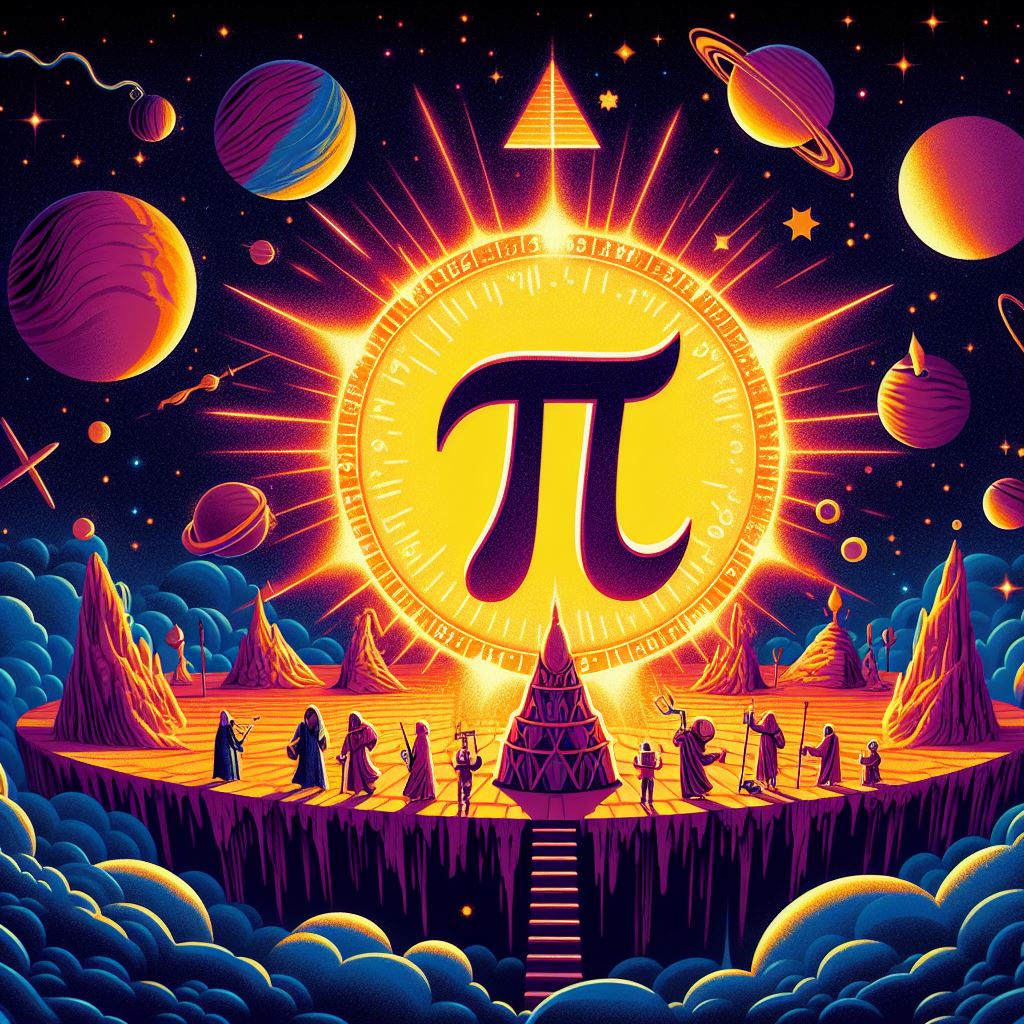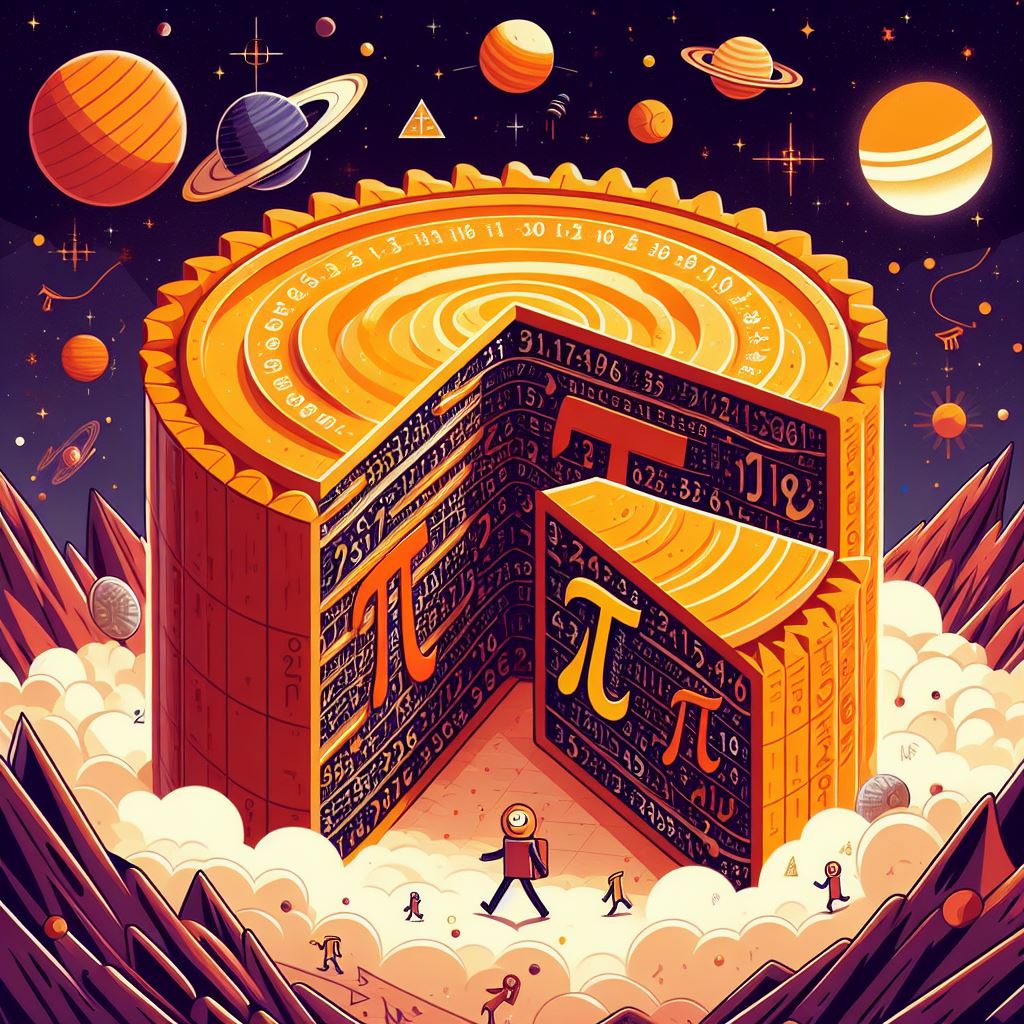Pi is a significant mathematical constant that connects a circle's diameter and circumference. It is an irrational number, which means that its decimal digits are infinite and non-repeating (Beckmann, 2023). Pi is widely used in formulas and calculations that include circles and spheres. Furthermore, pi appears unexpectedly in mathematical contexts that appear to be unconnected to circles.
This ScienceShot presents an overview of pi, including its definition, origin, mathematical history, and applications. The experimental derivation of pi is shown. Key historical breakthroughs in finding the digits of pi are noted.

Definition and Derivation of Pi
Pi (π) is defined as the ratio of a circle's circumference (the perimeter or distance around the circle) to its diameter (the straight line passing through the center of the circle connecting one side to the other). This ratio holds true for circles of any size.
Pi can be derived geometrically by a simple experiment. Using a compass, construct a circle on a piece of paper. Take a string and align it so that it wraps exactly once along the circumference. Carefully remove the string and straighten it out, then measure its length using a ruler. This length represents the circumference (C) of the constructed circle.
Next, using the ruler, directly measure the diameter (d) of the circle from one edge, straight through the center point, to the opposite edge. Regardless of the original circle's size, dividing its circumference (C) by its diameter (d) will result in a ratio that is approximately equal to 3.14.
Mathematically, this relationship can be summarized by the equation for circumference, where π represents the constant ratio between the circumference and diameter:
Circumference = π x Diameter
C = πd
Rearranging this formula leads to the definition for pi:
π = Circumference / Diameter
π = C/d
Furthermore, pi links the diameter or radius of a circle with its area. Consider a circle of radius r. Its area can be divided into small wedge-shaped slices radiating out from the center point. The curved edge of each wedge section approximates a straight line segment of length πr. As the number of wedges approaches infinity, summing their areas gives the total area. This yields the standard formula for the area (A) of a circle:
A = πr2
Interestingly, pi relates diagonal lengths within squares and their circumscribed circles. Begin with a circle and draw a square outward so that the sides are tangent to the circle. If the circle has diameter d, the diagonal length of this square will also be d.
Now place a smaller circle inside the square so that it touches all four sides. The diameter of this smaller circle is equal to the side length (s) of the original square. Applying the circumference formula shows its circumference is πs.
Noting the inner circle's circumference must equal the outer square's perimeter of 4s, an interesting geometrical derivation of pi results:
πs = 4s
π = 4
This demonstrates pi naturally linking the geometry of circles to squares.
Thus, pi fundamentally connects a circle's diameter to its circumference, area, and to other geometric shapes like squares. This deep relationship to basic geometric properties gives the ratio now known as pi great mathematical and scientific importance.
History of Pi Usage
Ancient civilizations recognized the existence and utility of the constant ratio of circumference to diameter now known as pi. Babylonians and Egyptians used approximate numerical values for pi in mathematical calculations as early as 2000 B.C (Beckmann, 2023). For example, the Babylonians used 25/8 (approximately 3.125) as their value, while the Egyptians used 256/81 (approximately 3.16) (Jones, 2013).
These ancient civilizations applied these numerical approximations for pi in various formulas related to circles and spheres. Evidence indicates the Babylonians utilized their rough value to estimate areas, volumes, and perimeters of circular shapes in architectural and engineering design problems (Jones, 2013). Additionally, the Egyptians applied their pi approximation in semidirect formulas to estimate enclosed areas and volumes (Jones, 2013).
Later, Greek mathematicians like Archimedes produced more accurate estimations through innovative approaches using polygon perimeters bounded by circumscribed circles. Archimedes established upper and lower bounds for pi which tightened the approximations considerably (Beckmann, 2023). His estimate of 22/7 (approximately 3.14) became widely adopted.
Subsequently, Chinese mathematicians like Zu Chongzhi used iterative algorithms building on these techniques to calculate pi to seven decimal places by 480 A.D. (Roy, 1990). Arab mathematicians continued incremental improvements between the 9th to 11th centuries A.D., achieving levels equivalent to nine decimal places (Fowler, 1987).
Jones (1706) first represented this important geometric ratio with the Greek letter π, likely abbreviating periphery. This notation was popularized in mathematics around 1736 (Beckmann, 2023). Since then, π became the standard symbol used to represent this constant in formulas across mathematics and the sciences.

With computational advances, more precise values for π have been obtained. By 1900 A.D., over 500 digits were established. Modern computers have allowed determination of over 6 billion known digits of π (Beckmann, 2023). However, as an irrational number, the digits of π are never ending.
Applications and Unexpected Occurrences of Pi
The ubiquity of pi relates to its presence across numerous mathematical and scientific contexts beyond simple geometry. Pi arises in many formulas in physics, engineering, and data science.
In physics, pi is an integral component of equations describing wave motion, electrostatics, quantum mechanics, and Einstein's field equations for relativity (Arfken et al., 2005). For example, the formula to determine the wavelength λ of a wave is:
λ = 2πc/ω
Where c is the wave propagation speed and ω is the angular frequency.
In engineering, approximation of shapes as circular is convenient for calculations like stress distributions in cylindrical pipes. Here pi naturally appears in equations for hoop stress based on radii and pressures (Boresi et al., 1993).
Additionally, pi is essential in various data transformations used for time series analyses in data science applications (Brillinger, 2001). The Fourier transform utilized in signal analysis contains integrals over angular frequencies defined in units containing pi.
Furthermore the below infinite series shows an example of the unexpected emergence of pi.
1 + 1/4 + 1/9 + 1/16 + 1/25 + ... + 1/n2 + ... = π2/6
This illustrates how pi arises in areas of mathematics not overtly related to geometry. Namely, analytic number theory and analysis of converging infinite series (Weisstein, 2004).
In summary, the ubiquity of pi across the quantitative sciences relates to its presence in diverse mathematical contexts beyond simple circumference and area formulas in basic geometry.
Conclusion
In summary, pi arose historically as a constant ratio relating circular dimensions. Standardized mathematical notation as π developed shortly after 1700 A.D. Computation has revealed pi to over 6 billion digits, although as an irrational number, the digits are endless. While originally derived geometrically, pi emerges surprisingly across many mathematical contexts and has wide-ranging utility for quantitative sciences.